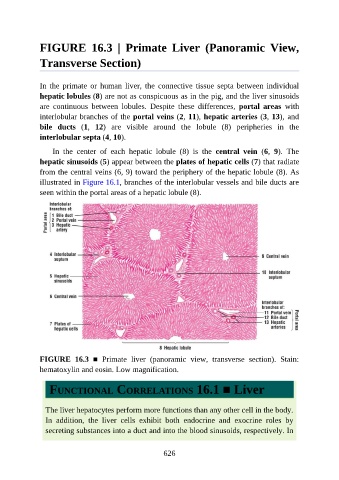Page 627 - Atlas of Histology with Functional Correlations
P. 627
FIGURE 16.3 | Primate Liver (Panoramic View,
Transverse Section)
In the primate or human liver, the connective tissue septa between individual
hepatic lobules (8) are not as conspicuous as in the pig, and the liver sinusoids
are continuous between lobules. Despite these differences, portal areas with
interlobular branches of the portal veins (2, 11), hepatic arteries (3, 13), and
bile ducts (1, 12) are visible around the lobule (8) peripheries in the
interlobular septa (4, 10).
In the center of each hepatic lobule (8) is the central vein (6, 9). The
hepatic sinusoids (5) appear between the plates of hepatic cells (7) that radiate
from the central veins (6, 9) toward the periphery of the hepatic lobule (8). As
illustrated in Figure 16.1, branches of the interlobular vessels and bile ducts are
seen within the portal areas of a hepatic lobule (8).
FIGURE 16.3 ■ Primate liver (panoramic view, transverse section). Stain:
hematoxylin and eosin. Low magnification.
FUNCTIONAL CORRELATIONS 16.1 ■ Liver
The liver hepatocytes perform more functions than any other cell in the body.
In addition, the liver cells exhibit both endocrine and exocrine roles by
secreting substances into a duct and into the blood sinusoids, respectively. In
626

